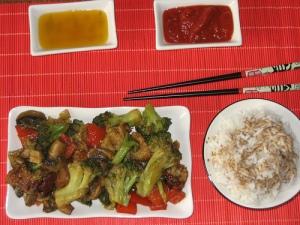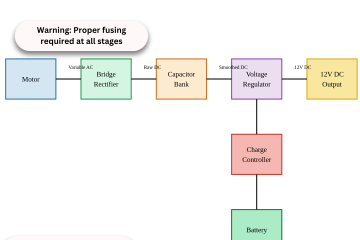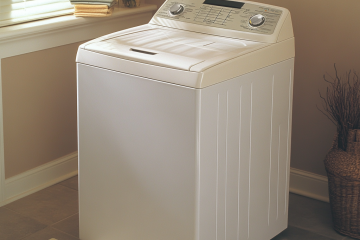Ribs, meatballs, steak, corned beef and ground beef–made from wheat? You bet! And it’s tasty too!!!
As covered in the last 2 days of our articles, “wheat meat” is a GREAT alternative for traditional protein sources in your food storage. It’s also healthy for you and requires less energy for your body to process than “regular meat.”
“Wheat meat” is also known as seitan (pronounced say-tan´), wheat gluten, and is sometimes also referred to as textured vegetable protein (TVP). Technically, wheat gluten is the part of the flour that you extract in order to make seitan/“wheat meat.”
Some folks get confused between what they find already packaged in the store labeled as “vital wheat gluten,” “vital wheat gluten flour,” or simply “wheat gluten” vs. what I’m teaching you to make from scratch for yourself. The stuff you find in the store, usually in small bags or small containers, is actually a bit more convenient way of making “wheat meat.” The wheat gluten, which is what you end up with then you rinse your dough, has already been commercially extracted from the flour. (This is a process that I don’t believe you can duplicate in your own home in a dry format.) Purchasing wheat gluten is more convenient because it eliminates the steps of kneading and rinsing prior to seasoning. This way you can add your seasoning right in with the wheat gluten flour and water and then cook it.
The reason why I’m not advocating purchasing it is because the wheat gluten flour is much more expensive than making it from scratch from your own wheat. Plus the extra steps really aren’t that much of a hassle or time consuming. The convenience of buying it at the grocery store comes a comparatively heavy price tag. It runs about $6-$8 for less than a pound. Considering that I just did a group buy for 50 pounds of wheat from a local farmer for $10, you can understand why I advocate just making it yourself. The good news though, is that the way I’m teaching you to make your own wheat meat produces the exact same result as the vital wheat gluten flour.
Today I’m providing you with some of my favorite recipes for wheat meat. Even the most ardent meat eater will be hard-pressed to dislike these dishes. Let the drooling begin!
Great Wheat Meat Recipe #1: BBQ Wheat Meat Ribs
After rinsing completely rinsing your wheat gluten mass, allow it to rest about 20 minutes. While it’s resting, combine the following ingredients in a bowl.
2 t. smoked paprika
2 T. nutritional yeast (not to be confused with the yeast you use to make bread)
2 t. onion powder
1 t. garlic powder
Mix these dry ingredients together with a fork. Then add:
2 T. peanut butter or almond butter, or cashew butter. (For those who may have nut allergies, you may substitute tahini.)
1 ½ t. liquid smoke (liquid or powdered will work fine)
1 T. of soy sauce. (I prefer to use low sodium)
With your hands, incorporate your rested gluten dough with this mixture until the ingredients looks evenly distributed.
Preheat your oven to 350 degrees F. and coat an 8×8 baking dish with cooking spray.
Put the dough into the baking dish and flatten it so that it evenly fills the pan. With a sharp knife, score the dough evenly into 16 rib shaped strips. (A sharp knife is key for this recipe)
Place your mixture in the oven and bake it for about 25 minutes. (You can also cook this in your solar oven for about 1 hour.) When it’s finished baking, re-score each strip. With a butter knife or spatula, gently loosen the ribs from the pan. (You’ll want them to stay in two 8- piece sections when it’s time to grill them.) Once you’ve loosened them a bit, coat the exposed side of the baked dough with your favorite barbeque sauce. (You can also substitute Chinese 5 Spice mixed with butter, Hoisin sauce, or sweet honey mustard.) The ribs turn out best if your sauce choice is nice and thick.
Prepare your grill with cooking spray, and heat to medium-high heat. Then remove the two 8-piece sections of ribs from the pan and place them sauce side down on a hot grill. Coat the exposed side of ribs with more sauce. Grill for about 3 minutes then turn over, and apply more sauce. You should grill them twice on each side, applying a generous amount of your favorite sauce.
Remove the ribs from the grill and serve with your favorite side dishes.
Great Wheat Meat Recipe #2: Mock Stir Fried Beef
Cut your steamed gluten into thin strips, like you would want your beef for a fajita or stir fry. (About1 inch x ½ inch and 1/8-1/4 inch thick.) See a brief, 30 second demonstration here. http://www.youtube.com/watch?v=JNo6kJB9SIY&feature=channel Then simmer it in 2 cups of the beef broth, 1 T. of soy sauce, and ½ t. of powdered ginger. Simmer in the broth until the liquid is mostly absorbed by the steamed gluten.
OR
You can marinate the steamed strips in an oriental sauce with a little fresh garlic.
THEN
In 1 T. of sesame oil, sauté the following in a hot wok or heavy skillet until the vegetables are tender:
3-4 T. of peach or plum jam
3-4 T. vinegar (white preferred)
2-3 T. soy sauce
2 C. of sliced Oriental style wheat meat
1 carrot—cut diagonally
1 C. cauliflower
1 C. broccoli (use the stems and florets—yum!)
1 green pepper, sliced
1 C. celery, chopped
1 medium onion, sliced
3-4 green onions, sliced, greens only
1 fresh garlic clove, minced
1 T. of fresh ginger, chopped
Enjoy. (That’s more of a demand, rather than a request. :))
Great Wheat Meat Recipe #3: Ha-cha-cha Wheat Meat Sausage
After kneading, take 2-3 C. of wheat meat and incorporate the following mixture with your hands:
1/2 C. nutritional yeast flakes
1/4 C. chickpea flour
2 T. poultry seasoning
2 T. granulated onion
2 T. ground or whole fennel seed
2 t. fresh, coarsely ground pepper
2 t. Spanish paprika
1 t. dried chili flakes, optional
1 t. ground smoked paprikat
1/2 t. oregano
1 t. sea salt
1/8 t. ground allspice
6 to 8 cloves garlic, minced or pressed
2 T. olive oil
2 T. soy sauce (low sodium)
After mixing with your hands, shape the dough into 8 sausage shaped links/logs (use ½ cup of dough for each link). Roll each link in foil, twisting the ends of the foil to secure the links. Place sausages in steamer and steam for 30 minutes. Remove sausages from steamer and cool. Once cooled, remove the sausages from foil and refrigerate until ready to eat. (Note, you can use cheesecloth and simply tie the ends instead of foil if you prefer.) This is GREAT served in a marinara sauce over pasta!
Wheat Meat Series
To see our upcoming event schedule, click here
Check out our inhome-course programs
Subscribe to Preparedness Pro today and never miss a thing!
For any questions or comments on this article, please leave a comment on the blog site so that everyone can benefit!
Copyright Protected 2009, Preparedness Pro and Kellene. All Rights Reserved. No portion of any content on this site may be duplicated, transferred, copied, or published without written permission from the author. However, you are welcome to provide a link to the content on your site or in your written works.






12 Comments
Debbie Olson · August 17, 2009 at 4:37 pm
woohoo, I got it to print, aparently it was me not you. I am so excited to try making wheat meat.
Thanks,
Mrs. Olson
Debbie Olson · August 17, 2009 at 4:37 pm
woohoo, I got it to print, aparently it was me not you. I am so excited to try making wheat meat.
Thanks,
Mrs. Olson
Stephanie · August 17, 2009 at 5:03 pm
Where is a good place to purchase nutritional yeast? We had an awesome restaurant in Georgia that we used to eat at that used it all the time in their vegan recipes, too. I’m excited to try out these new recipes.
Thanks!
Stephanie
Stephanie · August 17, 2009 at 5:03 pm
Where is a good place to purchase nutritional yeast? We had an awesome restaurant in Georgia that we used to eat at that used it all the time in their vegan recipes, too. I’m excited to try out these new recipes.
Thanks!
Stephanie
Kellene · August 17, 2009 at 6:35 pm
you shouldn’t have any problem getting that at any store that claims to be a “health food” store–it’s a staple. I’m in a relatively small city and I can get it 3 diffferent places.
Kellene · August 17, 2009 at 6:35 pm
you shouldn’t have any problem getting that at any store that claims to be a “health food” store–it’s a staple. I’m in a relatively small city and I can get it 3 diffferent places.
bjames · April 20, 2010 at 9:13 pm
I am a wheat meat newbie, and have followed the recipe meticulously. My question is how to avoid too firm and rubbery wheat meat. Am I simmering it too long? The recipes I have read have suggested simmering for about 1 1/2 hours. Would this length of cooking time create a “tough” consistency? I am trying to duplicate the soft, chewy consistency found in vegetarian Asian restaurants… mock chicken, beef, duck, etc.
Kellene · April 20, 2010 at 9:20 pm
Are you making it from scratch or from vital wheat gluten? That has a big difference in the texture. I enjoy it (wheat gluten way) much better, but learned the hard way to be patient and add more liquid right off the bat. I cook mine in my pressure cooker when I’m boiling it. You only want to boil it until it floats to the top. That should be extremely tender. You will also get different textures if you bake it, grill it or deep fry it.
bjames · April 20, 2010 at 9:13 pm
I am a wheat meat newbie, and have followed the recipe meticulously. My question is how to avoid too firm and rubbery wheat meat. Am I simmering it too long? The recipes I have read have suggested simmering for about 1 1/2 hours. Would this length of cooking time create a “tough” consistency? I am trying to duplicate the soft, chewy consistency found in vegetarian Asian restaurants… mock chicken, beef, duck, etc.
Kellene · April 20, 2010 at 9:20 pm
Are you making it from scratch or from vital wheat gluten? That has a big difference in the texture. I enjoy it (wheat gluten way) much better, but learned the hard way to be patient and add more liquid right off the bat. I cook mine in my pressure cooker when I’m boiling it. You only want to boil it until it floats to the top. That should be extremely tender. You will also get different textures if you bake it, grill it or deep fry it.
TP · May 31, 2013 at 1:12 am
I wanted to note that TVP is actually soy protein and not protein from gluten. While both are used as meat substitutes, they are very different beasts and are used somewhat differently.
TP · May 31, 2013 at 1:12 am
I wanted to note that TVP is actually soy protein and not protein from gluten. While both are used as meat substitutes, they are very different beasts and are used somewhat differently.
Comments are closed.